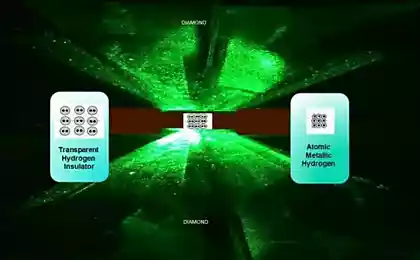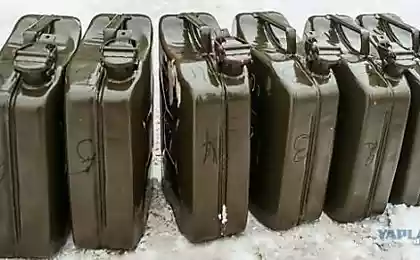569
BMW Hydrogen 7 - the adaptation of space technologies to terrestrial life
Space – the sphere of the most expensive, advanced and sophisticated technical solutions. From the standpoint of economy to limit the scope of efficient technologies only to space exploration – an unforgivable waste. To "land" the heavenly equipment of the European space Agency ESA has a Programme of technology transfer (Technology Transfer Programme TTP).
The purpose of TTP – adaptation of space technologies to terrestrial life. Working in the framework of the programme, the Austrian company MagnaSteyr has adapted developed for the rocket Arian system of transporting and storing liquid hydrogen for use in cars.
The advantages of hydrogen as an efficient and environmentally clean fuel is well known. However, its widespread use is hampered by certain properties of matter. The hydrogen molecule – the smallest in the Universe. It is extremely difficult to retain in a closed space.

To keep the hydrogen to use as rocket fuel, it is cooled to extremely low temperatures. But in this case, to the integrity of pipelines and vessels special requirements.
By order of the ESA company MagnaSteyr participated in the development of tanks and pipelines Arian. The main problem was to find a tough and durable seal material. After accumulating some experience, MagnaSteyr were able to apply it when you build the fuel system of the car, using as fuel hydrogen.
The result of a collaboration MagnaSteyr and BMW was the birth of bi-fuel BMW Hydrogen 7 that can run either on hydrogen or on gasoline. MagnaSteyr participation in the project was the development and creation of fuel tank and piping systems.
The temperature of liquid hydrogen is -253 degrees Celsius. To the hydrogen remained in liquid state, it must be cool. Instead, a 114-liter hydrogen tank of the BMW Hydrogen 7 is very well isolated from the environment. Its insulation efficiency is equivalent to a layer of foam polystyrene with a thickness of 17 meters. It allows you to keep the desired temperature inside the tank within two weeks.

During 2007-2008 BMW built 100 hydrogen-powered car. Some of these luxury sedans are still used to Shuttle VIPs at special events.
As notes a press-the Secretary of BMW's Ralph Huber (Ralph Huber): "We learned a lot with these machines. They have passed millions of kilometers." The project proved the feasibility but also drew attention to the limitations that must be found technical solution, before the cars are driven on liquid hydrogen will be massive.
Among the problems Ralph Hubert calls a limited number of hydrogen filling stations, they are in the world today less than a dozen. The second problem is the hydrogen still heats up and evaporates. For example, the owner returned to the abandoned airport hydrogen car in two weeks, catch it with an empty tank.
However, the "space tank" designed MagnaSteyr was the first step towards using hydrogen as a car fuel BMW cars. According to Ralph Huber: "In the long term, hydrogen will be one of our solutions for sustainability and mobility".
Source: /users/104
The purpose of TTP – adaptation of space technologies to terrestrial life. Working in the framework of the programme, the Austrian company MagnaSteyr has adapted developed for the rocket Arian system of transporting and storing liquid hydrogen for use in cars.
The advantages of hydrogen as an efficient and environmentally clean fuel is well known. However, its widespread use is hampered by certain properties of matter. The hydrogen molecule – the smallest in the Universe. It is extremely difficult to retain in a closed space.

To keep the hydrogen to use as rocket fuel, it is cooled to extremely low temperatures. But in this case, to the integrity of pipelines and vessels special requirements.
By order of the ESA company MagnaSteyr participated in the development of tanks and pipelines Arian. The main problem was to find a tough and durable seal material. After accumulating some experience, MagnaSteyr were able to apply it when you build the fuel system of the car, using as fuel hydrogen.
The result of a collaboration MagnaSteyr and BMW was the birth of bi-fuel BMW Hydrogen 7 that can run either on hydrogen or on gasoline. MagnaSteyr participation in the project was the development and creation of fuel tank and piping systems.
The temperature of liquid hydrogen is -253 degrees Celsius. To the hydrogen remained in liquid state, it must be cool. Instead, a 114-liter hydrogen tank of the BMW Hydrogen 7 is very well isolated from the environment. Its insulation efficiency is equivalent to a layer of foam polystyrene with a thickness of 17 meters. It allows you to keep the desired temperature inside the tank within two weeks.

During 2007-2008 BMW built 100 hydrogen-powered car. Some of these luxury sedans are still used to Shuttle VIPs at special events.
As notes a press-the Secretary of BMW's Ralph Huber (Ralph Huber): "We learned a lot with these machines. They have passed millions of kilometers." The project proved the feasibility but also drew attention to the limitations that must be found technical solution, before the cars are driven on liquid hydrogen will be massive.
Among the problems Ralph Hubert calls a limited number of hydrogen filling stations, they are in the world today less than a dozen. The second problem is the hydrogen still heats up and evaporates. For example, the owner returned to the abandoned airport hydrogen car in two weeks, catch it with an empty tank.
However, the "space tank" designed MagnaSteyr was the first step towards using hydrogen as a car fuel BMW cars. According to Ralph Huber: "In the long term, hydrogen will be one of our solutions for sustainability and mobility".
Source: /users/104























